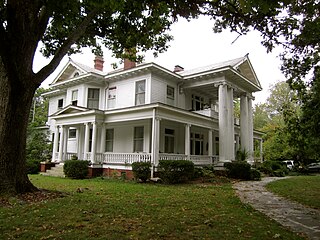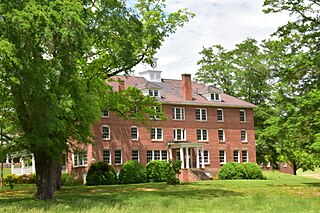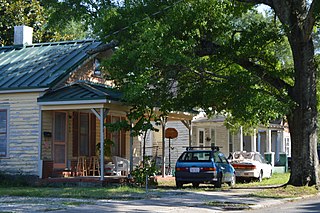
The Monroe Residential Historic District is a national historic district located at Monroe, Union County, North Carolina. It encompasses 376 contributing buildings, 1 contributing site, and 4 contributing objects in a predominantly residential section of Monroe. The district developed between about 1874 and 1940 and includes notable examples of Italianate, Queen Anne, and Classical Revival architecture styles and includes work by architects Wheeler & Stern and by G. Marion Tucker. Notable buildings include the R. V. Houston House, Houston-Redfearn House, the Belk House, J. H. Lee House, M. G. Sheppard House, Elizabeth Friedeman House, former Methodist Parsonage, Gaston Meares House, William E. Cason House, M. G. Sheppard House, and George B. McClellan House.

Ram Cat Alley Historic District is a national historic district located at Seneca, Oconee County, South Carolina. It encompasses 18 contributing buildings in the central business district of Seneca. They were built between about 1887 and 1930. Notable buildings include the Patterson Building, Harper and Jones Building, C. F. Adams General Store, Old Seneca Post Office, and Richardson Theatre.

Patterson School Historic District is a historic agricultural and Episcopal mission school complex and national historic district located at Legerwood, Caldwell County, North Carolina. The complex includes 13 contributing buildings, 2 contributing sites, and 3 contributing structures. Notable contributing resources include the Colonial Revival-style Palmyra Hall (1927), Sarah Joyce Lenoir Memorial Library, Gard Hall (1920-1921), Headmaster's House (1912), Buffalo Creek Dam (pre-1940), Milk House (1945), two Barns, North Silo (1920s), Chapel of Rest (1918), Jones-Patterson Cemetery, Hugh A. Dobbin House, and Tudor Revival-style Edgar A. Dobbin House (Greystone) (1930s). In 1994 the Episcopal Diocese of Western North Carolina sold the Patterson School property.

Cape Lookout Village Historic District is a national historic district located near Core Banks, Carteret County, North Carolina. It encompasses 20 contributing buildings 1 contributing site, and 6 contributing structures in Cape Lookout Village. The buildings include notable examples of Queen Anne and Bungalow / American Craftsman style architecture. The district includes two government complexes: the Cape Lookout Lighthouse Station and the Cape Lookout Coast Guard Station. In addition, 14 buildings, a long dock, and the circulation network, as well as the landscape in which these lie, compose the district. The buildings include the Life Saving Station (1888) and Boathouse, the Keeper's Quarters (1907), Luther Guthrie House, Gaskill-Guthrie House, Seifert-Davis House, Baker-Holderness House, the Bryant House, and the Carrie Arendell Davis House.

Roanoke Rapids Historic District is a national historic district located at Roanoke Rapids, Halifax County, North Carolina. It encompasses 1,130 contributing buildings, 5 contributing sites, 27 contributing structures, and 1 contributing structure in the central business district and surrounding residential sections of the town of Roanoke Rapids. The district includes notable examples of Queen Anne, Colonial Revival, and Bungalow / American Craftsman style architecture. Located in the district is the separately listed Roanoke Rapids High School. Other notable buildings include workers houses in four local mill villages, Driscoll-Piland-Webb House, Dickens-Webb House (1906-1907), Samuel F. Patterson (1914-1915), Council-Coburn House (1925-1927), First Presbyterian Church (1915), All Saints Episcopal Church designed by Hobart Upjohn (1917), (former) First Baptist Church (1928-1929), (former) Nurses Home and School (1930-1931), Clara Hearne Elementary School (1933-1935), (former) North Carolina National Guard Armory (1940-1941), (former) United States Post Office (1937-1938), Rosemary Drug Co. Building (1915-1916), Shelton Hotel, First National Bank Building (1914-1915), J. C. Penney and Co. Building (1938-1942), McCrory Co. Building (1940), Imperial Theatre Building, (former) Seaboard Air Line Passenger Station (1917), Rosemary Manufacturing Company complex, Patterson Mills Co. (1910), and Roanoke Mills Co. Plant No. 2. (1916-1917).

Harrellsville Historic District is a national historic district located at Harrellsville, Hertford County, North Carolina. The district encompasses 69 contributing buildings, 12 contributing sites, and 4 contributing structures in the village of Harrellsville. The buildings include notable examples of Greek Revival, Queen Anne, and Bungalow / American Craftsman architecture built between about 1827 and 1945. Notable contributing resources include the Sharp Family Cemetery, Abner Harrell House, J.L. Smith House (1910-1915), Taylor Warehouse (1900), Work Projects Administration built School Gymnasium (1935) and Harrellsville School Auditorium (1940), John Bembury Sharp House (1833), and R.C. Mason & Son Store (1905).
North Smithfield Historic District is a national historic district located at Smithfield, Johnston County, North Carolina. It encompasses 120 contributing buildings, 3 contributing sites, and 1 contributing structure in a predominantly residential section of Smithfield. It includes notable examples of Italianate and Queen Anne style architecture and buildings dating from about the 1850s through the 1940s. Notable buildings include the Lunceford-Narron House, Massey-Wilson House, Stevens-Mattox House, Allred-Pou-Wellons-McGowan House, (former) Smithfield Water Power Plant, and St Ann's Catholic Church (1935).
Downtown Selma Historic District is a national historic district located at Selma, Johnston County, North Carolina. It encompasses 59 contributing buildings and 1 contributing structure in the central business district of Selma. It includes notable examples of Classical Revival, Colonial Revival, Art Moderne, Art Deco, and Gothic Revival style architecture and buildings dating from about 1875 to 1960. Notable buildings include the Bank of Selma/American Telephone and Telegraph Exchange Building, Economy Furniture, John A. Mitchener Building (1925), The Rudy Theater, The Hardware Store, Bank of Selma, Selma Baptist Church, and Selma Manufacturing Company/Selma Furniture Store and Opera House (1902).

West Selma Historic District is a national historic district located at Selma, Johnston County, North Carolina. It encompasses 217 contributing buildings, 1 contributing site, and 1 contributing structures in predominantly residential section of Selma. It includes notable examples of Queen Anne, Gothic Revival, Moderne, and Bungalow / American Craftsman style architecture and buildings dating from about 1880 to 1961. Located in the district is the separately listed Nowell-Mayerburg-Oliver House and William E. Smith House. Other notable buildings include the Edgerton Memorial Methodist Episcopal Church, Abdalla House, Dr. Joshua W. Vick House, Stella and William H. Etheridge House, Dr. R. Marvin Blackmon House, Samuel P. Wood House (1935), Janie and C. E. Kornegay House (1923), Selma Presbyterian Church, St. Gabriel's Episcopal Church/Vernon Wiggs House, and Pepsi Bottling Company.
Lakeview Historic District is a national historic district located at Lakeview, Moore County, North Carolina. The district encompasses 43 contributing buildings, 1 contributing site, and 3 contributing structures in the early-20th century resort town of Lakeview. It was developed between the 1903 and 1940 and includes notable examples of Queen Anne and Classical Revival style architecture. Notable buildings include the Gardner House, Burr House, B. D. Usshur House, Newcomb-McFayden House, "Afterglow", and the Lakeview Presbyterian Church (1907).

Villa Place Historic District is a national historic district located at Rocky Mount, Nash County, North Carolina. It encompasses 321 contributing buildings and 1 contributing structure in a residential section of Rocky Mount. The buildings primarily date between about 1900 and 1950, and include notable examples of Queen Anne, Colonial Revival, Classical Revival, and Bungalow / American Craftsman style residential architecture. Located in the district is the separately listed Machaven. Other notable buildings include the W.D. Cochran House, Mills-Watson House, Aladdin Homes Company "kit houses," the James Craig Braswell School (1940), Draine Confectionery, and West End Grocery.

Main Street Commercial Historic District is a national historic district located at Hamlet, Richmond County, North Carolina. The district encompasses 23 contributing buildings, 3 contributing structures, and 1 contributing object in the central business district of Hamlet. It includes buildings built between about 1900 to about 1940 and notable examples of Queen Anne, Art Deco, and Classical Revival architecture. Located in the district is the separately listed Seaboard Air Line Passenger Depot. Other notable buildings include the Terminal Hotel, Union Building, the Bank of Hamlet (1912), the Old Hamlet Opera House, and the U.S. Post Office (1940), a Works Progress Administration project.

Maxton Historic District is a national historic district located at Maxton, Robeson County, North Carolina. The district encompasses 49 contributing buildings in the central business district and surrounding residential sections of Maxton. It includes buildings built between about 1884 to 1948 in a variety of popular architectural styles including Classical Revival. Notable buildings include the Cape Fear and Yadkin Valley (CF&YV) Railroad Freight Warehouse, Maxton Union Station (1913), Seaboard Air Line Railroad warehouse and office, First Presbyterian Church (1906), St. Paul's Methodist Episcopal Church (1906) designed by architect Henry E. Bonitz, Gilbert Patterson Law Office, A.J. MacKinnon House, and the R.L. MacLeod House.

Downtown Elkin Historic District is a national historic district located at Elkin, Surry County, North Carolina. The district encompasses 51 contributing buildings and 2 contributing structures in the central business district of Elkin. They were primarily built between about 1890 and 1950 and include notable examples of Early Commercial and Bungalow / American Craftsman architecture. Notable buildings and structures include the Gwyn-Foard House, Hugh G. Chatham Bridge (1931), Liberty Tobacco Warehouse, Harris Building (1902), U.S. Post Office (1937) designed by the Office of the Supervising Architect under Louis A. Simon, former Elkin Town Hall (1938–1939) built by the Works Progress Administration, Dobbin's Store, and the Riverside Hotel (1915–1925).

The Waxhaw–Weddington Roads Historic District is a national historic district located at Monroe, Union County, North Carolina. It encompasses 18 contributing buildings, 2 contributing structures, and 1 contributing object in a predominantly residential section of Monroe. The district developed between about 1897 and 1940 and includes notable examples of Prairie School, Queen Anne, and Classical Revival architecture styles and includes work by architects Charles Christian Hook and by G. Marion Tucker. Notable buildings include the Redwine Tenant House (1907), Robert B. Redwine House (1908), Heath House (1897), Edward Crow House (1916), and Crow's Nest.

The Waxhaw Historic District is a national historic district located at Waxhaw, Union County, North Carolina. It encompasses 93 contributing buildings, 3 contributing structures, and 1 contributing object in the central business district and surrounding residential sections of Waxhaw. The district developed between about 1888 and 1940 and includes notable examples of Commercial Style, Queen Anne, and Bungalow / American Craftsman style architecture. Notable buildings include the former Post Office (1905), Harris's store, Tyson Store, A.W. Heath Co. Mill (1905), R.J. Belk Company Store, A.W. Heath Company Stores, Weir Building, Plyler Building, Farmer's Ginning & Trading Company, McDonald Hotel (1912), Waxhaw Presbyterian Church (1929), Duncan McDonald House, and Ralph J. Belk House.

Carpenter Historic District is a national historic district located near Cary, Wake County, North Carolina. The districts encompasses 66 contributing buildings, 1 contributing site, and 8 contributing structures in the rural crossroads community of Carpenter. The district developed between about 1895 and 1933, and includes notable examples of Late Victorian and Colonial Revival style architecture. Notable buildings include the Carpenter Farm Supply Company, D. Judson Clark Machine/Garage, Byrd-Ferrell House, Mallie and Cora Butts Farm, A.M. Howard Farm, and Barbee-Williams Farm.
Downtown Garner Historic District, also known as Garner's Station, is a national historic district located at Garner, Wake County, North Carolina. The district encompasses 62 contributing buildings and 1 contributing site in the central business district and surrounding residential sections of Garner. The district developed between about 1883 and 1940 and includes notable examples of Queen Anne, Classical Revival, and Bungalow / American Craftsman style architecture. Notable buildings include the Garner Depot, (former) Garner High School (1923), Hayes Chapel Christian Church, H. D. Rand Store, Bank of Garner Building, Section Foreman's Bouse, Joe Broughton Bouse, J. J. Bagwell House, W. L. Brooks House, and D. B. Buffaloe House (1923).

Valle Crucis Historic District is a national historic district located at Valle Crucis, Watauga County, North Carolina. The district encompasses 50 contributing buildings, 1 contributing site, and 7 contributing structures in the central business district and surrounding residential sections of Valle Crucis. It developed between about 1812 and 1954, and includes notable examples of Gothic Revival, Bungalow / American Craftsman, and Colonial Revival style architecture. Located in the district are the separately listed Mast General Store, Mast Farm, and Valle Crucis Episcopal Mission. Other notable contributing buildings are the Baird Farm, Lucy Mast Olsen House (1936-1940), Taylor tobacco barn, Farthing Store (1909), Valle Crucis Bank (1914), Hard Taylor House, and C. D. "Squire" Taylor House (1911).

East Wilson Historic District is a national historic district located at Wilson, Wilson County, North Carolina. It encompasses 858 contributing buildings and 2 contributing structures in a historically African-American section of Wilson. The district developed between about 1890 to 1940 and includes notable examples of Queen Anne, Bungalow / American Craftsman, and Shotgun style architecture. Notable buildings include the Reverend Henry W. Farrior House, Charles Thomas House, Samuel Vick House, Dr. Mathew Gillam House, Wilson Colored High School (1924), and Samuel H. Vick Elementary School (1939).




















